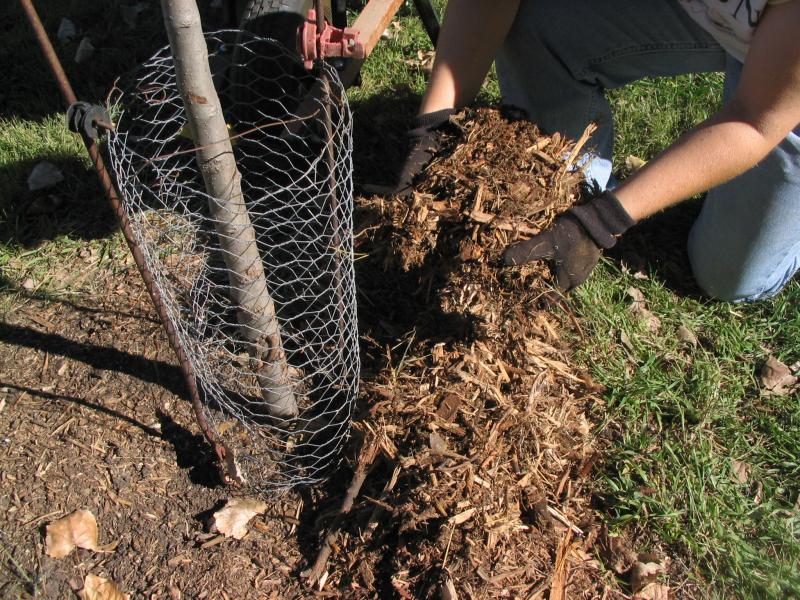
In late April, many people will celebrate Arbor Day by planting a tree. Using good planting techniques and providing good care during a tree's first few years are critical for getting a tree off to a good start, and ensuring vigorous growth and health throughout it's life.
Planting Depth
First make sure to plant the tree at the proper depth. The first main root emerging from the tree's trunk should be just an inch or two below the soil and the tree's root flare should be visible at the soil surface. If the sides of the tree go straight into the ground, like the sides of a telephone pole, then the tree is planted too deeply. This will significantly limit root development and vigor of the tree for it's entire life.
To find the first main root, remove the tree from it's container or remove the burlap around the top of the root ball. If the soil is loose and easy to work, gently rough up the top of the root ball to remove excess soil until you find the first main root. With heavier soil use a flat tile spade to shave off the top of the root ball until you find the first main root, being careful not to damage the main trunk. Tease out any circling roots or if the tree is very root-bound make several cuts down the sides of the root ball then tease out the roots.
If possible, purchase a tree grown in a "grow bag". These fabric-like containers help prevent the development of circling roots and encourage growth of a dense root system within the fabric container. Remove the grow bag container before planting the tree in the ground.
Dig a wide, shallow hole, loosening the soil around the sides, but don't loosen the soil beneath the root ball. As the loose soil beneath the root ball settles, the tree could sink and eventually be placed too deep in the soil.
Place the tree in the planting hole at the correct depth, spread the roots out and gently backfill with soil. Don't use your feet to compact the soil around the roots, which can result in soil compaction. Use your hands to firm the soil around the roots.
Watering
Water is critical to success. After planting, water the new tree thoroughly to settle soil around the roots and eliminate any air pockets. During the first few months, monitor moisture in the root ball frequently and water as needed. Trees generally require 1 inch of water per week, but keep in mind that soil composition plays an important role. Clay soil retains more water for longer periods than sandy soil, so watering may not be required every week in clay soil when temperatures are cool. When watering soak the root ball and the surrounding area to encourage root growth into surrounding soil. Water trees deeply, moistening the top 6-8 inches of soil, but infrequently to encourage good root development.
Mulch
Mulching is another important post-planting practice that can improve the health and vitality of landscape plants. Research has shown a 2-3 inch application of wood chip mulch nearly doubles plant growth in the first few years after planting. Mulch conserves moisture and insulates roots from heat and cold extremes. Proper mulching provides a well-groomed appearance to new plantings, eliminates grass or weed competition and prevents damage from mowers and weed trimmers.
Desirable mulching materials include wood chips, wood shavings, bark or equivalent materials. Coarse-textured organic mulches are preferred since they tend to aerate the soil and replenish soil nutrients as they decompose. Apply a 2-3 inch mulch layer, with a diameter of at least 2 feet, around your tree, but prevent the mulch from laying right against the trunk of the tree by pulling it away from the bark 1-2 inches.
Pruning
Trees and shrubs should be pruned at planting time only to remove branches damaged during handling and transplanting. Lower branches shouldn't be removed because they manufacture critically needed food and contribute to trunk growth.
Staking & Fertilization
Staking is not required for most new trees, unless they are in an extremely windy location, and then only for one year. Fertilization is also not necessary or recommended in the first few years after planting. Nitrogen fertilizer encourages foliage development, when the most important thing for your new tree is root development. Let it develop a good root system, then it will produce a full canopy of foliage.
For ideas on trees that grow well in Nebraska, visit the Nebraska Forest Service Trees to Plant or the Nebraska Statewide Arboretum What to Plant. Choose a great tree and get it off to a good start with good planting and maintenance techniques, and it will be a beautiful feature in your landscape for many years to come!